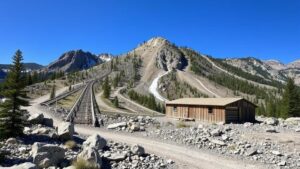The Story of Early Placer Mining Operations Near White Signal, New Mexico
The Story of Early Placer Mining Operations Near White Signal, New Mexico
Placer mining, the process of extracting valuable minerals from alluvial deposits, played a significant role in the mining history of the American West. In particular, the area near White Signal, New Mexico, witnessed early placer mining operations that contributed to the economic landscape of the region. This article delves into the history, techniques, and impact of these operations, highlighting their importance in the broader context of American mining endeavors.
Historical Context of Placer Mining
The origins of placer mining in the United States can be traced back to the California Gold Rush of 1849, which ignited a frenzy of gold seekers moving westward. While California often takes center stage, other regions, including New Mexico, experienced their own rushes, especially after precious metal discoveries. In New Mexico, the mining boom began in the late 19th century, driven by the discovery of gold and silver.
Early Mining Operations in White Signal
White Signal, a small mining town located in the southwestern part of New Mexico, became an epicenter for placer mining activities in the 1880s. The discovery of gold in nearby streambeds attracted prospectors and miners looking for fortune. As the news spread, the area saw an influx of miners seeking to exploit the alluvial deposits along the streambanks.
Early operations were largely characterized by simple, manual methods. Miners utilized basic tools such as pans, shovels, and sluice boxes to extract gold from the soil and sediment. The process involved several steps:
- Using a shovel to gather earth from streambeds.
- Employing a pan to wash away lighter materials, leaving heavier gold particles.
- Constructing sluice boxes to manage larger volumes of material while capturing gold.
The simplicity of these techniques allowed many individuals, including unskilled laborers, to participate in mining. success of placer mining in White Signal led to greater advancements and larger operations as the demand for gold surged.
Technological Advances and Their Impact
As the placer mining industry matured, technological innovations enhanced efficiency and productivity. One significant advancement was the introduction of hydraulic mining methods. This involved the use of high-pressure water jets to dislodge material, which was then directed to a sluice for gold separation. This technique, though highly effective, raised environmental concerns regarding sediment displacement and river siltation.
By the late 19th century, larger mining companies began to invest in more advanced equipment, which expanded operations further. The introduction of steam-powered machinery revolutionized the extraction process, allowing miners to process greater quantities of earth and access deeper deposits.
Economic and Social Impact
The placer mining operations near White Signal had significant economic implications. The influx of miners contributed to the local economy, providing jobs and stimulating related industries, such as supply stores, transportation, and services. As mineral wealth was extracted, some miners achieved substantial fortunes, leading to a burgeoning middle class in the area.
Socially, the mining boom contributed to a diverse and often transient population. Individuals and families from various backgrounds flocked to the area, fostering a rich cultural landscape. But, this migration also brought challenges, including competition for resources and land, labor disputes, and environmental degradation.
The Legacy of Placer Mining in New Mexico
Although placer mining operations near White Signal eventually dwindled as easily accessible deposits were exhausted, their influence can still be seen today. historical footprint of these activities has prompted ongoing interest in mining heritage and preservation. Modern companies occasionally revisit these sites for potential exploration, while educational initiatives aim to inform the public about the regions mining history.
Today, placer mining is still practiced in a more regulated manner, balancing environmental considerations with economic viability. The legacy of placer mining has helped shape policies regarding land use and natural resource management in New Mexico, reinforcing the need for sustainable practices.
Actionable Takeaways
Understanding the history of placer mining in areas like White Signal can inform contemporary practices and policies surrounding mineral extraction. Stakeholders should consider:
- Useing sustainable mining practices that minimize environmental impact.
- Fostering community engagement and education about mining heritage.
- Exploring technological advancements while ensuring safety and environmental protection.
The story of early placer mining operations near White Signal, New Mexico, serves as a testament to the complexities of resource extraction. As history shows, the balance between economic ambition and environmental stewardship remains a critical consideration for all involved in the mining industry.



